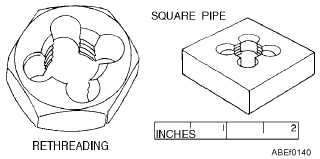You may have to make gaskets of rubber, cork,
leather, or composition materials. For cutting holes in
gasket materials, a hollow shank GASKET PUNCH
may be used (fig. 1-50). Gasket punches come in sets of
various sizes to accommodate standard bolts and studs.
The cutting end is tapered to a sharp edge to produce a
clean uniform hole. To use the gasket punch, place the
gasket material to be cut on a piece of hard wood or lead
so that the cutting edge of the punch will not be
damaged. Then strike the punch with a hammer, driving
it through the gasket where holes are required.
REVIEW QUESTIONS
Q22.
Identify the different types of punches.
Q23.
What is a center punch used for?
Q24.
What is a prick punch used for?
TAPS AND DIES
LEARNING OBJECTIVES: Identify the
different types of taps and dies. Describe the
uses of different types of taps and dies.
Taps and dies are used to cut threads in metal,
plastics, or hard rubber. The taps are used for cutting
internal threads, and the dies are used to cut external
threads. There are many different types of taps.
However, the most common are the taper, plug,
bottoming, and pipe taps (fig. 1-53).
The taper (starting) hand tap has a chamfer length
of 8 to 10 threads. These taps are used when starting a
tapping operation and when tapping through holes.
Plug hand taps have a chamfer length of 3 to 5
threads and are designed for use after the taper tap.
Bottoming hand taps are used for threading the
bottom of a blind hole. They have a very short chamfer
length of only 1 to 1 1/2 threads for this purpose. This
tap is always used after the plug tap has been used. Both
the taper and plug taps should precede the use of the
bottoming hand tap.
Pipe taps are used for pipefitting and other places
where extremely tight fits are necessary. The tap
diameter, from end to end of the threaded portion,
increases at the rate of 3/4 inch per foot. All the threads
on this tap do the cutting, as compared to the straight
taps, where only the nonchamfered portion does the
cutting.
Dies are made in several different shapes and are of
the solid or adjustable type. The square pipe die (fig.
1-54) will cut American Standard Pipe thread only. It
comes in a variety of sizes for cutting threads on pipe
with diameters of 1/8 inch to 2 inches.
A rethreading die (fig. 1-54) is used principally for
dressing over bruised or rusty threads on screws or
bolts. It is available in a variety of sizes for rethreading
American Standard Coarse and Fine threads. These
dies are usually hexagon in shape and can be turned
1-34
Figure 1-53.—Types of common taps.
Figure 1-54.—Types of solid dies.



